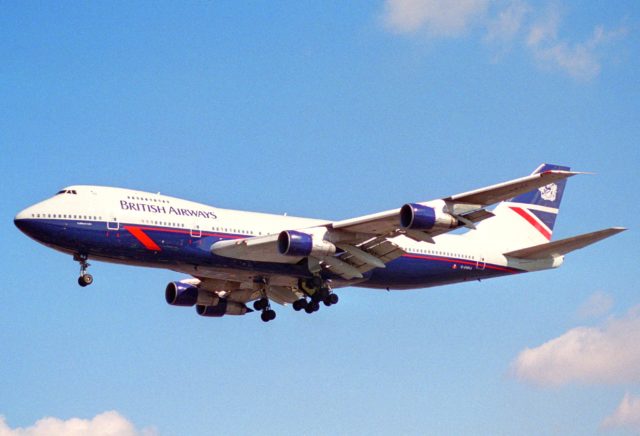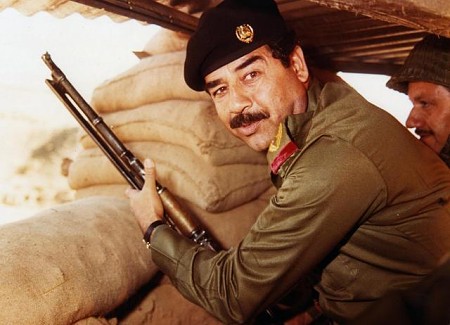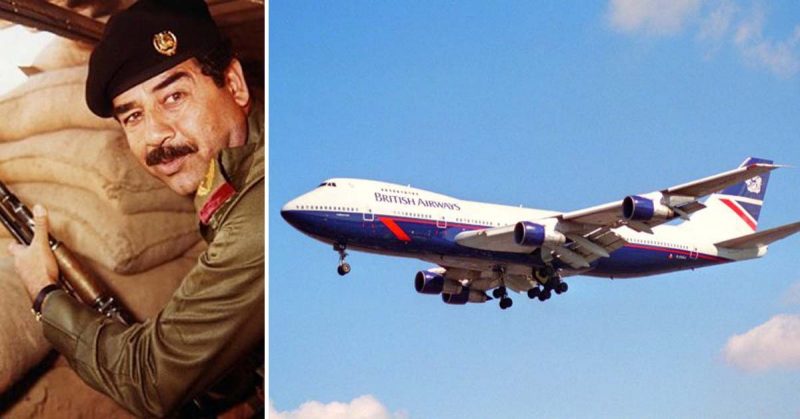The sounds of gunfire, of bombs exploding and military combat. Unknown hotel rooms, military and industrial sites, and an abandoned airport. Sudden, random acts of terror – mock executions, and physical and mental torture.
These were the sounds, the sights, and the actions that occurred in the last months of 1990 to the British Airways Flight 149 passengers and flight crew. Taken hostage in Kuwait in the midst of the Iraq army’s invasion, those who boarded Flight 149 took an unexpected detour that brought the horrors of war directly into their lives.
On August 1, 1990, 367 travelers and 18 airline crew members boarded British Airways Flight 149 at Heathrow Airport in London. Those aboard the plane were prepared for a lengthy, but uneventful flight: the plane would first stop for a brief layover in Kuwait City, pause again for another quick stop in Madras (the city now known as Chennai), and then reach its final destination at the Sultan Abdul Aziz Shah Airport in Kuala Lumpur.
However, those aboard Flight 149 never set down in Malaysia. Instead, they spent months in Kuwait, terrified of what lay ahead – and worried that they may never see their homes or loved ones again.
Trouble began brewing hours before Flight 149 was scheduled to take off. Tensions between Kuwait and Iraq were reaching dangerous heights, and the international community knew that Saddam Hussein was prepared to act – and soon. Media outlets in England, the United States, and other locales around the world reported that Kuwait was becoming increasingly dangerous.
In the last weeks of July, Saddam Hussein demanded that Kuwait’s leaders surrender some of their territories to Iraqi control. As soon as these demands were issued, Iraq military forces moved into position and began increasing the number of troops waiting at the Kuwait-Iraq border. As the political situation between Iraq and Kuwait intensified, military forces began gathering in the region, and experts worldwide warned travelers to stay far from the growing conflict.

None of this altered the plans for British Airways, however. Flight 149 remained scheduled as originally intended, with no changes to its itinerary. Despite the many warnings, the plane and its passengers were to stop in Kuwait City. Though the rest of the world may have been preparing for an invasion or attack on Kuwait’s borders, the British Airways flight plans went forward unaltered.
Before takeoff, however, Flight 149 faced a small problem: a mechanical delay. Passengers waited for several hours at Heathrow Airport as a crew worked to repair a fault in the plane’s auxiliary power unit. Finally, in the early evening hours of August 1st, the crew began boarding Flight 149.
At 18:05 GMT, with 367 passengers and 18 crew members aboard, Flight 149 took off and left the safety of London. While the plane was cruising towards its first destination, Iraq made its first move – the nation’s military invaded Kuwait, intent on taking control of the territories Hussein had been denied. Hours later, in the midst of the invasion, Flight 149 touched down at Kuwait International Airport at 1:13 GMT on August 2.
The crew emptied the plane, as usual, sending passengers into the airport to wait for the scheduled hour-long layover. However, when the travelers entered the building, they found it completely deserted. There was no airline or airport staff present; no fellow travelers headed to different destinations, and no crew on the ground.
Because of the dangerous political situation, all other airlines had canceled their planned flights to avoid landing at Kuwait Airport. While the passengers of Flight 149 waited at the airport, unaware of what was happening in the city, they heard gunfire shots ring out and the explosions of tanks firing.
Not surprisingly, these wartime sounds made both the passengers and the crew uneasy; instead of remaining at the airport for the entire duration of the layover, the crew began boarding its travelers back onto the plane at 2:05. Before Flight 149 could hit the runway and head for its next stop in Madras, bombs exploded in its path. The Iraqi military had arrived at the Kuwait Airport.
Stranded in their Boeing 747, the plans of the passengers and crew of Flight 149 were about to change. By 4:30, more than two hours after they re-boarded, members of the Iraq military removed everyone from the plane and took them to a nearby hotel via bus. The following morning, reports began circulating the world that those aboard Flight 149 were all alive, safe, and unharmed. However, their journey was far from over.
The passengers and crew spent their first days in Kuwait confined to a hotel not far from their airport itself. Over the course of their capture, the Iraqi military moved them to different locations throughout the city. For months, the passengers bounced from hotel to hotel and were even taken out of Kuwait and into Iraq at times.
After the first ten days under Iraqi control, the passengers and crew were divided; some were taken to different military or industrial sites while others were moved to new hotels. Though the Iraqis claimed that the individuals from Flight 149 were “honored guests” and not, in fact, hostages, the passengers were never free from armed escorts and the watchful eyes of Iraqi police officers and soldiers.
The passengers, or hostages, were certainly not treated as guests – they watched as Iraqi soldiers carried out horrific acts of violence upon Kuwaiti citizens, and underwent both physical and mental abuse themselves. Members of the Iraq military would terrorize the hostages with mock executions and rapes, leading the captured people of Flight 149 to live overwhelmed by fear and panic.
Freedom would eventually be granted to some of the prisoners, but not all of them. In another torturous tactic, the Iraqi military released individuals at different times and for different reasons. As August 1990 drew to a close, Iraq allowed women and children to return home. The remaining hostages were forced into even more dismal and dangerous situations.
Hussein upped his horrifying actions by using the hostages as human shields, guarding himself against deadly gunfire and death by holding their innocent bodies in front of his own and his most important military locations.
In the months that followed that first hostage release, the Iraqis allowed other groups to make their way home as well: the handicapped or ill were the next to be granted freedom, followed by the body of the one who had died in Iraqi captivity. Some citizens earned their freedom because they were from France, Germany, or Japan; the U.S. and British hostages were the last to be released.
In an effort to speed up the release of the Flight 149 hostages, many government officials from around the world reached out to Saddam Hussein. However, it was former British Prime Minister Edward Heath who successfully negotiated the hostages’ release. Heath flew to Baghdad and spoke with Hussein in person and, finally, the last hostages returned home in December 1990.

Four months after their ordeal began on August 1, the last individuals from Flight 149 arrived home. Although they were back in the safety of their own countries, the controversy surrounding British Airways and the airline’s decision to fly straight into Kuwait was not over.
In the years after their safe return, many Flight 149 passengers took legal action against British Airways. The various lawsuits cited negligence, loss of property, and damages – some of the French passengers won their argument in July 1999, when British Airways paid GB£2.5 million in damages.
Over 15 years after the events of Flight 149, more legal action took place when some the passengers requested a public inquiry into the events of August 1st, 1990. The accounts of what happened on that date, and with the decision to send a flight into the heart of the Kuwait-Iraq conflict, are still debated today.
Some have stated that the military had British Airways believe the region was safe and stable; others have denied any such discussion took place. Although the true events and decision-making process that led to the capture of the more than 300 hostages may never become clear, the plight of the passengers and crew went down in history as a key event in the build-up to the Gulf War.
